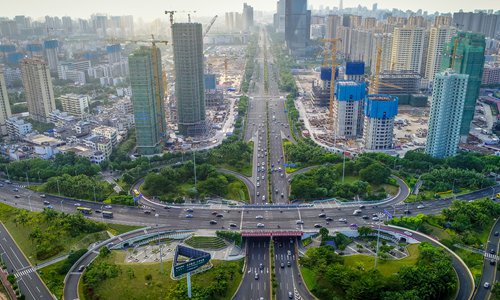Hainan's star set to rise
By Chu Daye and Chi Jingyi Source:Global Times Published: 2020/6/1 22:28:41 Last Updated: 2020/6/1 20:52:41

A view of the Hainan Free Trade Zone in October, 2018 Photo: VCG
China unveiled on Monday a much-anticipated master plan for the Hainan free trade port, aiming to build the tropical island province into a globally influential, high-level free trade port by the middle of the century.
Chinese President Xi Jinping underlined the high-quality, high-standard construction of the Hainan free trade port while prioritizing the innovation of institutional integration in the process.
Xi, who announced the decision to develop Hainan into a pilot free trade zone during a visit to the island in April 2018, stressed that efforts should be made to align it with high-level international economic and trade rules, facilitate the free and convenient flow of the factors of production, and prioritize the innovation of institutional integration.
The blueprints include numerous policies, such as duty-free import status for a broad range of industries, the gradual opening-up of the capital account, more access in the sphere of data, and freer cross-border flows of people and capital.
To achieve these goals, a set of free trade port policies focusing on trade and investment liberalization and facilitation across the entire island of Hainan will be rolled out by 2025 and be refined by 2035, according to the plan jointly issued by the Central Committee of the Communist Party of China and the State Council, China's cabinet.
Chinese experts said the rise of a world-class free trade port from what are now picturesque beaches will redefine China's relationships with its major trading and investment partners in the decades to come.
"Hainan will morph from being the remote southernmost province of China to become the focal point of three large regions: the Chinese hinterland, Northeast Asia featuring South Korea and Japan, and the vast market of the Association of Southeast Asian Nations (ASEAN)," said Liang Haiming, dean of the Belt and Road Institute at Hainan University.
This change will happen in the context of ASEAN's rising importance as a trade and investment partner of China and intensifying trade conflicts between China and the US, the second-largest and largest economies in the world.
ASEAN overtook the EU as China's largest trading partner in the first quarter of 2020 and ASEAN's standing will be further supported by the finalization of the Regional Comprehensive Economic Partnership free trade agreement, set to be signed later in 2020.
China is expected to import more than $30 trillion worth of goods and $10 trillion worth of services over the coming 15 years, media reports said in 2018.
The China-proposed Belt and Road Initiative (BRI) will also have Hainan as a vital node.
"The demographic dividends in the financial, services and consumption industries within China's free trade zones have just begun to yield results. Companies from countries and regions along the route of the BRI are expected to flock in to invest in China's special zones," Liang said, adding that such a desire has always been strong but deterred by unfamiliarity.
New foreign direct investment in the tourism, modern services and high-tech sectors will be exempted from corporate income tax until 2025, according to the blueprint. Foreign educational institutions in the areas of science, engineering, agriculture, and in medical and technical training, can also set up wholly owned entities on the island.
Hu Qimu, a senior fellow at Sinosteel Economic Research Institute, said the strategy also has implications for other influential global cities in the region.
"Looking at it from a long-term perspective, having an internationally influential free trade center within its borders will be a well-placed hedge to address both the prolonged China-US trade friction and the unrest in Hong Kong," Hu told the Global Times on Monday.
Tian Yun, a vice director of the Beijing Economic Operation Association, told the Global Times on Monday that the Hainan free trade port will be an experiment in how China can become a globally recognized developed country.
"It is a pilot project with China in the driver's seat to lead the next round of globalization, amid a wave of anti-globalization sentiment in some major Western countries," Tian noted.
The master plan also contains proposals to build innovation centers and trial areas for blockchain technology, cruise ships and the yacht sector.
Posted in: INDUSTRIES